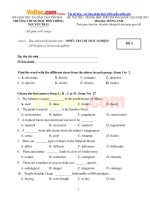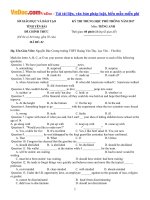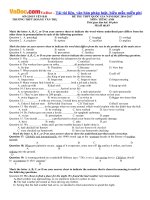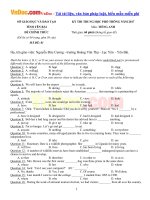Tải Đề thi thử THPT Quốc gia năm 2017 môn Tiếng Anh trường THPT Cảm Ân, Yên Bái CÓ ĐÁP ÁN (1) - Đề thi thử THPT Quốc gia năm 2017 môn Tiếng Anh có đáp án
Bạn đang xem bản rút gọn của tài liệu. Xem và tải ngay bản đầy đủ của tài liệu tại đây (132.61 KB, 6 trang )
<span class='text_page_counter'>(1)</span><div class='page_container' data-page=1>
<b>SỞ GIÁO DỤC VÀ ĐÀO TẠO </b>
<b>YÊN BÁI </b>
<b>Mã đề: 645</b>
<b>KỲ THI TỐT NGHIỆP THPTQG NĂM 2017</b>
<b>Môn: TIẾNG ANH </b>
<i>Thời gian làm bài: 60 phút. (Không kể thời gian giao đề)</i>
<i><b>Mark the letter A, B, C, or D on your answer sheet to indicate the word whose underlined part is </b></i>
<i><b>pronounced differently from that of the rest in each of the following questions.</b></i>
<i><b>Question 1: A. leaves</b></i> B. brings C. looks D. plays
<i><b>Question 2: A. watched</b></i> B. promoted C. invited D. decided
<i><b>Mark the letter A, B, C, or D on your answer sheet to indicate the word whose stress pattern is </b></i>
<i><b>different from that of the rest in each of the following questions.</b></i>
<i><b>Question 3: A. water</b></i> <b> B. bamboo</b> <b>C. eject</b> <b>D. defend</b>
<i><b>Question 4: A. opponent</b></i> <b> B. habitat</b> <b>C. vacancy</b> <b>D. sociable</b>
<i><b>Mark the letter A, B, C, or D on your answer sheet to indicate the underlined part that needs</b></i>
<i><b>correction in each of the following questions.</b></i>
<i><b>Question 5: Vietnam exports a lot of rice is grown mainly in the south of the country.</b></i>
A. <b> B. </b> <b> C. D.</b>
<i><b>Question 6: Hardly he had entered the office when he realized that he had forgotten his wallet. </b></i>
A. <b> B. </b> <b> C. D.</b>
<i><b>Question 7:Today was such beautiful day that I couldn't bring myself to complete all my chores.</b></i>
<b> A. </b> <b> B. C</b> <b> D</b>
<i><b>Mark the letter A, B, C or D on your answer sheet to indicate the correct answer to each of the </b></i>
<i><b>following questions.</b></i>
<i><b>Question 8: Last month I went to visit the college ________ I studied from 1985 to 1990.</b></i>
<b>A. where</b> <b>B. that</b> <b>C. who</b> <b>D. when</b>
<i><b>Question 9: Bob has a bad lung cancer and his doctor has advised him to ________ smoking.</b></i>
<b>A. turn up B. give up C. take up</b> <b>D. put up</b>
<i><b>Question 10: The majority of Asian students reject the American ________ that marriage is a </b></i>
partnership of equals.
<b>A. thought</b> <b>B. view</b> <b>C. look</b> <b>D. attitude</b>
<i><b>Question 11: A number of wildlife reserves have been established ________ endangered species </b></i>
can have a chance to survive and develop.
<b>A. therefore</b> <b>B. in order to</b> <b>C. so that</b> <b>D. so as to</b>
<i><b>Question 12: We will leave for the airport ________ he is ready.</b></i>
<b>A. as soon as</b> <b>B. during C. until</b> <b>D. while </b>
<i><b>Question 13: Did you read ________ book I lent you last week?</b></i>
<b>A. a</b> <b>B. an</b> <b>C. the</b> <b>D. Ø</b>
<i><b>Question 14: If she ________ a car, she would go out in the evening.</b></i>
<b>A. has</b> <b>B. have</b> <b>C. had</b> <b>D. has had</b>
<i><b>Question 15: Traditionally, Americans and Asians have very different ideas ________ love and </b></i>
marriage.
<b>A. to</b> <b>B. at</b> <b>C. about</b> <b>D. in</b>
<i><b>Question 16: During the week of national tourism festival, we had visitors _______ from all over </b></i>
the country.
<b>A. to come B. coming</b> <b>C. come D. to have come</b>
<i><b>Question 17: The more you practise your English, ________ .</b></i>
<b>A. you will learn faster</b> <b>B. the faster you will learn</b>
<b>C. faster you will learn</b> <b>D. the faster will you learn</b>
<i><b>Question 18: I will not be here next week. I am going to be ________ business in Mexico.</b></i>
<b>A. about</b> <b>B. in</b> <b>C. on</b> <b>D. at</b>
</div>
<span class='text_page_counter'>(2)</span><div class='page_container' data-page=2>
<b>A. would have avoided </b> <b>B. would have avoid</b>
<b>C. avoid </b> <b>D. have avoided</b>
<b>Mark the letter A,B,C or D on your anser sheet to indicate the most suitable response to </b>
<b>complete each of the following exchanges.</b>
<i><b>Question 20: Diana: ‘I didn't know you could play the guitar so well, Toan. Your tune was </b></i>
<b>lovely!’ Toan: ‘________.’</b>
<b>A. You are welcome</b> <b>B. I bought it near my house last week</b>
<b>C. You've got to be kidding! I thought it was terrible D. Never mind</b>
<i><b> Question 21: Jack: ‘Can I use your computer?’ Jill: ‘________.’</b></i>
<b>A. No, thanks </b> <b>B. Of course</b> <b>C. Well done</b> <b>D.Yes,Ican</b>
<i><b>Mark the letter A, B, C or D on your answer sheet to indicate the word or phrase that is </b></i>
<i><b>CLOSEST in meaning to the underlined part in each of the following questions.</b></i>
<i><b>Question 22: What do you like doing in your spare time?</b></i>
<b>A. enjoyable</b> <b>B. free</b> <b>C. quiet</b> <b>D. busy</b>
<i><b>Question 23: Thanks to the invention of microscope, biologists can now gain insights into the</b></i>
nature of the human cell.
<b>A. deep understanding</b> B. far-sighted views
C. spectacular sightings D. in-depth studies
<i><b>Mark the letter A, B, C or D on your answer sheet to indicate the word(s) OPPOSITE in meaning</b></i>
<i><b>to the underlined word(s) in each of the following questions. </b></i>
<i><b>Question 24: About 95 percent of all animals are invertebrates which can live anywhere, but most,</b></i>
like the starfish and crabs, live in the ocean.
<b>A. with ribs</b> <b>B. without ribs C. without backbones </b> D.with backbones
<i><b>Question 25: Mr. Smith’s new neighbors appear to be very friendly.</b></i>
A. amicable B. inapplicable C. hostile D. futile
<i><b>Mark the letter A, B, C or D on your answer sheet to indicate the sentence that is closest in</b></i>
<i><b>meaning each of the following questions.. </b></i>
<i><b>Question 26. “ You didn’t do what I said” The mother said to the son.</b></i>
A. The mother accused her son on not doing what she said.
B. The mother accused her son in not doing what she said.
C. The mother accused her son with not doing what she said.
D.The mother accused her son of not doing what she said.
<i><b>Question 27.They last visited me five years ago.</b></i>
A. They haven’t visited me for a long time.
B. I haven’t been visited for a long time
C. They haven’t visited me for five years.
D. They have known me for five years.
<i><b>Question 2</b></i>8. I only recognized him when he came into the light.
A. Only when I recognized him, he came into the light.
B. It wasn’t until he came into the light that I recognized him
C. Not until he came into the light I did recognize him
D. I did not recognize him even when he came into the light.
<i><b>Mark the letter A, B, C or D on your answer sheet to indicate the sentence that best combines</b></i>
<i><b>each pair of sentences in the following questions. </b></i>
<i><b>Question 29. He was born in 1983. There was a severe drought that year.</b></i>
</div>
<span class='text_page_counter'>(3)</span><div class='page_container' data-page=3>
<i><b>Question 30. Although she was very old, she looked very gradeful</b></i>
A.Despite she was very old, she looked very gradeful
B.Despite her old age , she looked very gradeful
C.In spite of vey old , she looked very gradeful
D.In spite of being vey old , she looked very gradeful
<i><b>Read the following passage and mark the letter A, B, C or D on your answer sheet to indicate the </b></i>
<i><b>correct word for each of the blanks.</b></i>
One of the most urgent environmental problems in the world today is the shortage of clean
water. Having clean drinking water is a basic human right. But acid rain, (1) ________ pollution
and garbage have made many sources of water undrinkable. Lakes, reservoirs and even entire seas
have become vast pools of poison. Lake Baikal in Russia is one of the largest lakes in the world. It
(3) ________ a rich variety of animals and plants, including 1,300 rare species that do not exist
anywhere else in the world. But they are being destroyed by the massive volumes of toxic effluent
which pour into the lake every day. Even where law existed, the government did not have the power
to enforce them.
Most industries simply ignore the regulations. The Mediterranean Sea occupies 1% of the
world's water surface. But it is the dumping (7) ________ for 50% of all marine pollution. Almost
16 countries regularly throw industrial wastes a few miles away shore.
Water is free to everyone. A few years ago, people thought that the supply of clean water in
the world was limitless. Today, many water supplies have been (9) ________ by pollution and
sewage. Clean water is now scarce, and we are at last beginning to respect this precious (10)
________. We should do something now.
(Source: v14ilovetranslation.com)
<i><b>Question 31: A. industrious</b></i> <b> B. industry </b> <b>C. industrial </b> <b>D.</b>
industrialized
<i><b>Question 32: A. composes</b></i> <b> B. contains</b> <b>C. encloses </b> <b>D. consists</b>
<i><b>Question 33: A. shore</b></i> <b> B. land</b> <b>C. ground</b> <b>D. soil</b>
<i><b>Question 34: A. ruined</b></i> <b> B. kept</b> <b>C. made</b> <b>D. conserved</b>
<i><b>Question 35: A. well</b></i> <b> B. outlet</b> <b>C. nature</b> <b>D. source</b>
<i><b>Read the following passage and mark the letter A, B, C, or D on your answer sheet to indicate the</b></i>
<i><b>correct answer to each of the questions.</b></i>
Ever since humans inhabited the earth, they have made use of various forms of
communication. Generally, this expression of thoughts and feelings has been in the form of oral
speech. When there is a language barrier, communication is accomplished through sign language in
which motions stand for letters, words, and ideas. Tourists, the deaf, and the mute have had to resort
<b>to this form of expression. Many of these symbols of whole words are very picturesque and exact</b>
and can be used internationally; spelling, however, cannot.
Body language transmits ideas or thoughts by certain actions, either intentionally or
<b>unintentionally. A wink can be a way of flirting or indicating that the party is only joking. A nod</b>
signifies approval, while shaking the head indicates a negative reaction.
Other forms of nonlinguistic language can be found in Braille (a system of raised dots read
with the fingertips), signal flags, Morse code, and smoke signals. Road maps and picture signs also
guide, warn, and instruct people.
While verbalization is the most common form of language, other systems and techniques also
express human thoughts and feelings.
Source: TOEFL Reading)
<i><b>Question 36: Which of the following best summarizes this passage?</b></i>
A. When language is a barrier, people will find other forms of communication.
B. Everybody uses only one form of communication.
C. Nonlinguistic language is invaluable to foreigners.
D. Although other forms of communication exist, verbalization is the fastest.
</div>
<span class='text_page_counter'>(4)</span><div class='page_container' data-page=4>
A. tourists B. the deaf and the mute C. thoughts and feelings D. sign language
motions
<i><b>Question 38: All of the following statements are true EXCEPT</b></i>
A. there are many forms of communication in existence today
B. verbalization is the most common form of communication
C. the deaf and mute use an oral form of communication
D. ideas and thoughts can be transmitted by body language
<i><b>Question 39: Which form other than oral speech would be most commonly used among blind</b></i>
people?
A. Picture signs B. Braille C. Body language D. Signal flags
<i><b>Question 40: How many different forms of communication are mentioned here?</b></i>
A. 5 B. 7 C. 9 D. 11
<i><b>Question 41: The word "wink" in paragraph 2 means most nearly the same as</b></i>
A. close one eye briefly B. close two eyes briefly
C. bob the head up and down D. shake the head from side to side
<i><b>Question 42: Sign language is said to be very picturesque and exact and can be used internationally</b></i>
EXCEPT for
A. spelling B. ideas
C. whole words D. expressions
<i><b>Read the following passage and mark the letter A, B, C, or D on your answer sheet to indicate the</b></i>
<i><b>correct answer to each of the questions.</b></i>
<b> Rachel Carson was born in 1907 in Springsdale, Pennsylvania. She studied biology at</b>
college and zoology at Johns Hopkins University, where she received her master’s degree in 1933. In
1936, she was hired by the U.S. Fish and Wildlife Service, where she worked most of her life.
<i><b> Carson’s first book, Under the Sea Wind, was published in 1941. It received excellent reviews,</b></i>
<i><b>but sales were poor until it was reissued in 1952. In that year she published The Sea Around Us,</b></i>
which provided a fascinating look beneath the ocean’s surface, emphasizing human history as well as
geology and marine biology. Her imagery and language had a poetic quality. Carson consulted no less
than 1,000 printed sources. She had voluminous correspondence and frequent discussions with
experts in the field. However, she always realized the limitations of her nontechnical readers.
<i><b> In 1962, Carson published Silent Spring, a book that sparked considerable controversy. It</b></i>
<i><b>proved how much harm was done by the uncontrolled, reckless use of insecticides. She detailed how</b></i>
they poison the food supply of animals, kill birds and fish, and contaminate human food. At the time,
spokesmen for the chemical industry mounted personal attacks against Carson and issued propaganda
<i><b>to indicate that her findings were flawed. However, her work was proved by a 1963 report of the</b></i>
President’s Science Advisory Committee.
(Source: TOEFL Reading)
<i><b>Question 43. The passage mainly discusses Rachel Carson’s work</b></i>
<b>A. as a researcher B. at college </b>
<b>C. at the U.S. Fish and Wildlife Service D. as a writer</b>
<i><b>Question 44. According to the passage, what did Carson primarily study at Johns Hopkins</b></i>
University?
<b>A. oceanography B. zoology C. literature D. history</b>
<i><b>Question 45. When she published her first book, Carson was closest to the age of</b></i>
<b>A. 26 B. 29 C. 34 D. 45</b>
<i><b> Question 46. It can be inferred from the passage that in 1952, Carson’s book Under the Sea Wind</b></i>
<b>A. was outdated B. became more popular than her other books </b>
<b>C. was praised by critics D. sold many copies</b>
<i><b>Question 47. Which of the following was NOT mentioned in the passage as a source of information</b></i>
<i><b>for The Sea Around Us?</b></i>
</div>
<span class='text_page_counter'>(5)</span><div class='page_container' data-page=5>
<i><b>Question 48. Which of the following words or phrases is LEAST accurate in describing The Sea</b></i>
<i><b>Around Us?</b></i>
<b>A. highly technical B. poetic C. fascinating D. well-researched</b>
<i><b>Question 49. The word “reckless” in line 11 is closest in meaning to </b></i>
<b>A. unnecessary B. limited C. continuous D. irresponsible</b>
<i><b>Question 50. According to the passage, Silent Spring is primarily</b></i>
<b>A. an attack on the use of chemical preservatives in food</b>
<b>B. a discussion of the hazards insects pose to the food supply</b>
<b>C. a warning about the dangers of misusing insecticides</b>
<b>D. an illustration of the benefits of the chemical industry</b>
<b>SỞ GIÁO DỤC VÀ ĐÀO TẠO </b>
<b>YÊN BÁI</b>
<b>ĐÁP ÁN VÀ THANG ĐIỂM</b>
<b>Multiple choices (0,2x50=10 points)</b>
<b>Mã đề 645</b>
<b>Mã đề 732</b>
<b>Question 1</b>
1. C
1. D
<b>Question 2</b>
2. A
2. B
<b>Question 3</b>
3. A
3. B
<b>Question 4</b>
4. A
4. A
<b>Question 5</b>
5. B
5. D
<b>Question 6</b>
6. A
6. D
<b>Question 7</b>
7. A
7. D
<b>Question 8</b>
8. A
8. A
<b>Question 9</b>
9. B
9. A
<b>Question 10</b>
10. B
10.D
<b>Question 11</b>
11.C
11. C
<b>Question 12</b>
12. A
12. C
<b>Question 13</b>
13. C
13. A
<b>Question 14</b>
14. C
14. C
<b>Question 15</b>
15. C
15. D
<b>Question 16</b>
16. B
16. A
<b>Question 17</b>
17. B
17. D
<b>Question 18</b>
18. C
18. B
<b>Question 19</b>
19. A
19. D
<b>Question 20</b>
20. C
20. B
<b>Question 21</b>
21. B
21. A
<b>Question 22</b>
22. B
22. C
<b>Question 23</b>
23. A
23. C
<b>Question 24</b>
24. D
24. A
<b>Question 25</b>
25. C
25. D
<b>Question 26</b>
26. D
26. D
<b>Question 27</b>
27. C
27. D
<b>Question 28</b>
28. B
28. D
<b>Question 29</b>
29. A
29. A
</div>
<span class='text_page_counter'>(6)</span><div class='page_container' data-page=6>
<b>Question 31</b>
31. C
31. C
<b>Question 32</b>
32. B
32. C
<b>Question 33</b>
33. C
33. D
<b>Question 34</b>
34. A
34. D
<b>Question 35</b>
35. D
35. A
<b>Question 36</b>
36. A
36. B
<b>Question 37</b>
37. D
37. B
<b>Question 38</b>
38. C
38. C
<b>Question 39</b>
39. B
39. B
<b>Question 40</b>
40. C
40. B
<b>Question 41</b>
41. A
41. B
<b>Question 42</b>
42. A
42. D
<b>Question 43</b>
43. D
43. A
<b>Question 44</b>
44. B
44. D
<b>Question 45</b>
45. C
45. A
<b>Question 46</b>
46. D
46. C
<b>Question 47</b>
47. C
47.B
<b>Question 48</b>
48. A
48. A
<b>Question 49</b>
49. D
49. B
</div>
<!--links-->









